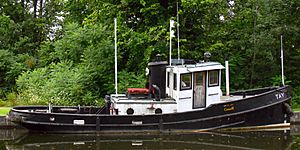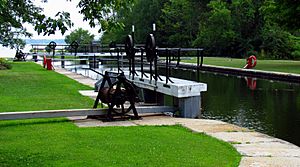Tay Canal facts for kids
The Tay Canal is a special waterway in eastern Ontario, Canada. It connects the town of Perth to the famous Rideau Canal. This connection happens at Beveridge Bay on Lower Rideau Lake. The canal is about 9.8 kilometers (6.1 miles) long. Today, Parks Canada looks after the Tay Canal. It's part of their work managing the Rideau Canal. At the start of the Tay Canal, there are two locks called Upper and Lower Beveridge Locks. These locks lift boats a total of 7.6 meters (25 feet).
Contents
History of the Tay Canal
Building the First Tay Canal
People first thought about making the Tay River a waterway for boats way back in 1824. A businessman from Perth, William Morris, really pushed for this idea. When the Rideau Canal started being built in 1826, Perth businesses hoped the Tay River would be included. But the main engineer for the Rideau Canal, Lt. Colonel John By, wasn't allowed to build any side canals.
So, a group decided to create a company to build the Tay Canal themselves. In 1831, a law was passed to form the Tay Navigation Company. John Jackson, a former army sergeant and a miller from Perth, won the job to build the canal. The plan was to connect Perth to the mouth of the Tay River. The locks were designed to be smaller than those on the Rideau Canal. They were 27 meters (89 feet) long and 6.1 meters (20 feet) wide. The water in the canal would be about 1.1 meters (3.6 feet) deep. This was a cheaper way to build it. People thought it would be big enough for most boats used for trade back then. By the end of 1834, five locks, six dams, two swing bridges, and several earth walls were finished. This first waterway became known as the First Tay Canal.
However, the First Tay Canal was not very successful for businesses. It didn't make enough money to be properly looked after. Over the years, the canal got into bad shape. In 1865, some of the locks were broken by floating logs, and the canal had to close down.
Building the Second Tay Canal
After the First Tay Canal closed, people started asking for a new one. The Government of Canada took over the old Tay Navigation Company. In 1881, they started looking into making the Tay River usable for boats again. John G. Haggart, who was Perth's local Member of Parliament, helped get this investigation started. Engineers from the Rideau Canal studied two possible routes. One route followed the path of the old First Tay Canal. The second route involved digging a new canal from Beveridge Bay to the Tay River.
The second route was chosen, which disappointed people in Port Elmsley. In 1883, the Government of Canada approved a plan to build the new Tay Canal. This plan included making the whole waterway deeper, about 1.7 meters (5.6 feet). It also meant digging a new canal cut that was 18 meters (59 feet) wide and 2 kilometers (1.2 miles) long to Beveridge Bay. Two new locks were built near the end of this new canal cut. Each lock would lift boats about 4.0 meters (13 feet). A flat dam was also built across the old Tay River channel.
The new locks were built to be just like the locks on the Rideau Canal. Construction started in early 1885 and was finished in 1887. The final digging to make the canal deep enough for boats, and making the boat basin in Perth bigger, wasn't fully done until 1891. For a while, the canal from the Beveridges Locks to Perth was even called "Haggart's Ditch" after the politician who helped make it happen.
The Tay Canal Today
Today, Parks Canada still manages the Tay Canal. It's an important part of the Rideau Canal system. Under normal conditions, the canal can handle boats up to 27.4 meters (90 feet) long. Boats can be up to 7.9 meters (26 feet) wide and 6.7 meters (22 feet) tall. The water depth needed for boats is up to 1.5 meters (5 feet). If a boat needs more than 1.2 meters (4 feet) of water, its captain should contact the Rideau Canal Office before their trip. The locks on the Tay Canal are open for boats from mid-May to mid-October each year.
One thing to know if you're boating all the way into Perth is the height of the Craig Street bridge. It's only 2.1 meters (7 feet) tall. If your boat is taller than this, you'll need to park it at Last Duel Park. This park is just a short walk from downtown Perth. If your boat is shorter than 2.1 meters but taller than 1.6 meters (5.2 feet), you will need the Beckwith Street Bridge to swing open. This lets you get into the Perth basin. Boat captains should tell the lock staff at Beveridges if they need the bridge to swing. The staff can tell them when it will open.




